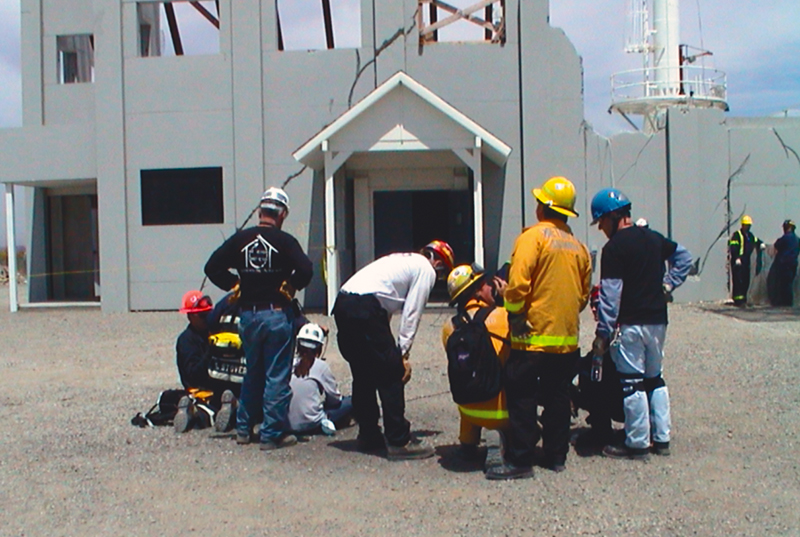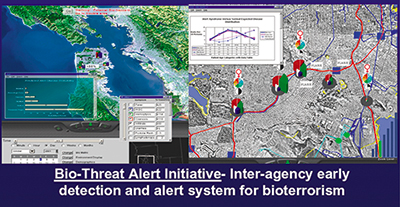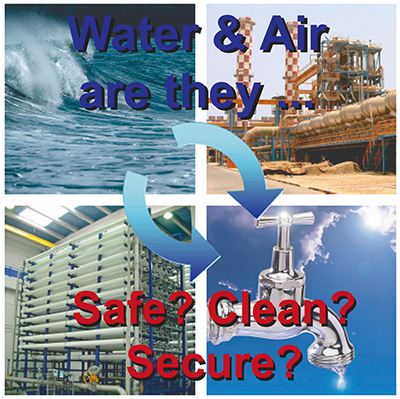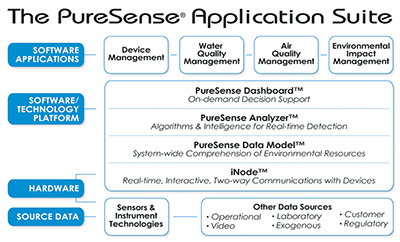
Water and Air Measures That Make ‘PureSense’
Originating Technology/NASA Contribution
Each day, we read about mounting global concerns regarding the ability to sustain supplies of clean water and to reduce air contamination. With water and air serving as life’s most vital elements, it is important to know when these environmental necessities may be contaminated, in order to eliminate exposure immediately.
The ability to respond requires an understanding of the conditions impacting safety and quality, from source to tap for water, and from outdoor to indoor environments for air. Unfortunately, the “time-to-know” is not immediate with many current technologies, which is a major problem, given the greater likelihood of risky situations in today’s world.
Accelerating alert and response times requires new tools, methods, and technologies. New solutions are needed to engage in more rapid detection, analysis, and response. This is the focus of a company called PureSense Environmental, Inc., which evolved out of a unique relationship with NASA.
The need for real-time management and operations over the quality of water and air, and the urgency to provide new solutions, were reinforced by the events of September 11, 2001. This, and subsequent events, exposed many of the vulnerabilities facing the multiple agencies tasked with working in tandem to protect communities from harmful disaster. Much has been done since September 11 to accelerate responses to environmental contamination. Partnerships were forged across the public and private sectors to explore, test, and use new tools. Methods and technologies were adopted to move more astutely from proof-of-concept to working solutions.
NASA was, and continues to be, involved in a number of these efforts, drawing on support from its experience and expertise with complex systems, advanced technologies, and environmental sciences. The founders of PureSense originally approached NASA to position the Agency’s expertise and technologies into inter-agency exercises directed at improving the protection and security of water systems and response to emergencies impacting water and air. These exercises and the subsequent partnership between NASA and PureSense helped to launch a unique solution for accelerating alert time and quickening the ability to respond
In the spring of 2002, NASA and several of the eventual founders of PureSense sponsored a series of work sessions for emergency response and water system agencies, with representation from a wide variety of Federal, state, local, and first-response officials. The sessions focused on understanding how to deal more effectively with bioterrorist attacks.
The would-be founders of PureSense brought experience in building and using multidisciplinary applications of real-time intelligence systems and communications technology; these were integrated into a proof-of-concept hardware and software system application to support collaborative surveillance, detection, response, and recovery. The system demonstrated several of NASA’s remote-sensing, advanced data-analysis, simulation, and scientific data-visualization technologies and repurposed them alongside other technologies and applications to facilitate cohesive, rapid decision-making across the agencies.
These experiences, coupled with a dedication to prevent water and air contamination from harming people and infrastructure, ultimately led to the launch of the PureSense company. PureSense, with the help of the NASA Technology Partnerships Division, initially opened an office on the NASA Research Park campus at Ames Research Center. The company recently moved to Emeryville, California, and continues to collaborate with NASA in bringing the Agency’s expertise in several areas to projects concerned with homeland security.
Today, PureSense is providing customers in the commercial and municipal markets with the first cost-effective online service to detect, know, and respond immediately to critical changes in the quality of water and air, and to do so in real time. PureSense hardware and related firmware first integrate diverse remote sensors, instruments, and remediation technologies, and then network them for continuous, standard data acquisition. Additionally, PureSense software applications perform data integration, validation, and analysis to provide customers with continuous intelligence on critical conditions over secure communication channels and via multiple types of communication devices. Included in the analytical data model are data-mining algorithms developed by the company’s founders, in collaboration with scientists at NASA. These algorithms have been repurposed and integrated into PureSense’s air and water system-monitoring software product, known as the PureSense Environmental Resource Management (ERM) Solution.
Partnership
The PureSense founders, including team members who at one time worked in Ames’s Biomedical Visualization and Gravitational Research laboratories, worked to reinforce the NASA-PureSense partnership through the signing of two Space Act Agreements in 2003, designed to support the NASA mission to “protect our planet.” Specifically, these agreements were designed to support the evaluation of NASA data-mining algorithms for incorporation in the analytics engine that is a component of the PureSense ERM Solution. These algorithms help NASA remotely monitor the physiological health of astronauts, evaluate atmospheric changes on Earth, conduct aviation system analysis, and discover and understand new galaxies.
The Space Act Agreements also led to PureSense partnering with the Agency’s scientists on emergency-response protocols, software systems, and advanced data analysis. Equally important, this type of partnering helps PureSense to generate recognition in the environmental industry for relevant NASA research and development capabilities while also supporting NASA in its relationships with other government agencies, national laboratories, and key industry players concerned with the Nation’s water and air quality. Subsequently, in 2004, PureSense signed a Cooperative Agreement with Ames to collaborate on U.S. Department of Homeland Security projects designed to ensure the security of the Nation’s water systems. PureSense has also collaborated with NASA on projects to develop and improve techniques and tools used in urban search and rescue.
Product Outcome
Industry and the public are facing a rising tide of costs associated with the contamination of air and water. For example, in 2004, Chiron Corporation was unable to meet its flu vaccine production commitments due to microbial cross-contamination in a manufacturing facility. After an estimated $300 million loss in enterprise value and 6 months of plant downtime, the company regained its license to produce flu vaccine for 2005. Also, beverage companies have lost millions of dollars annually worldwide, as contamination during production has led to product recalls (e.g., The Coca-Cola Company’s Dasani purified water was recalled after levels of bromate were found to exceed legal levels); lost inventory; and damaged brand identity. In 1990, North Carolina regulators issued a report stating that Perrier’s bottled water was contaminated with benzene, a poisonous liquid shown to cause cancer in laboratory animals. Perrier attributed the contamination to an isolated incident, in which workers failed to filter out the benzene—which the company said is naturally present in carbon dioxide—during the filtration process.)
In addition, U.S. hospitals incur $5 billion per year in direct costs from the transmission of infections inside their facilities that cause patients to become ill. Moreover, “sick building syndrome” in office buildings produces $30 billion to $50 billion per year in related health care costs and lost employee productivity in America. The State of California estimates that poor indoor air quality in non-industrial settings costs the economy $45 billion a year. Further, annual costs of asthma in the United States are estimated to be $18 billion, with $10 billion in direct costs, and another $3 billion in lost productivity from 15 million missed or lost work days. These experiences are more and more common as current practices in environmental monitoring fail to prevent problems from occurring.
PureSense’s cost-effective ERM systems are shaping up to be the answer to the health and monetary issues affecting both industry and the public. PureSense’s NASA-inspired solution helps transform the management of water and air from periodic batch processing to continuous, real-time understanding, based on automated, system-wide monitoring of environmental conditions.
The PureSense ERM Solution consists of a unique combination of hardware and software applications (known as the PureSense Application Suite) with the ability to access and aggregate data from multiple sensors and other data sources, add value to the data through analysis, and supply on-demand intelligence to users anytime, anywhere.
Four core components are fed by multiple data sources to provide an information and communications platform and produce comprehensive, real-time analysis of water and air quality for rapid detection, predictive analysis, and focused action.
The first component is a “pervasive computing” device, called the PureSense iNode, which provides two-way communication with existing or future air or water sensors. The iNode pre-processes information and transmits it over highly secured wireless connections to a centralized data center. The second component is a real-time data-collection network called the PureSense Data Model that, according to the company, gathers data faster and more economically than current “grab sample” methods (involving manual collection of samples for laboratory analysis) and enables the integration of disparate data sets from multiple sources. The third component, the PureSense Analyzer, employs sophisticated algorithms and NASA-influenced data-mining techniques to correlate multiple streams of data to produce real-time alerts and other analyses regarding environmental conditions. The fourth component, the PureSense Dashboard, is tailored to individual user profiles and communicates critical, real-time analysis to users in a timely manner. In the water industry, this is the powerful, role-based response system that keeps all responsible parties informed about key changes in water quality.
PureSense has developed aggressively over the last year, creating customer traction and new projects on the national level, with the U.S. Environmental Protection Agency and the Department of Homeland Security, among others. The company chose municipal drinking water as the best avenue for commercialization of existing NASA technologies and has already completed initial customer installations. Early endorsements for the PureSense ERM Solution have been received from some of the Nation’s largest water companies, including the Los Angeles Department of Water and Power, the second-largest municipal water company in the United States, and several other water companies that each serve over a million customers, including the East Bay Municipal Utility District, the Las Vegas Valley Water District, and the San Jose Water Company.
PureSense is currently expanding the capabilities of the PureSense ERM Solution for faster analysis and remediation in new vertical markets. The initial expansion includes hospitals and biopharmaceutical manufacturing, where it can help mitigate infectious disease incidences and, hence, drive down operational risks and associated costs. PureSense is now working with one of the largest hospital systems in California to adapt the PureSense ERM Solution for indoor air quality management. The company is also exploring interest from the food and beverage industries, where it can help minimize downtime and materials spoilage.
The partnership between NASA and PureSense has resulted in a business that is poised to have a dramatic impact on many different industries and on the lives of many people, with the potential to revolutionize environmental monitoring and control.
PureSense® is a registered trademark of PureSense Environmental, Inc.
Environmental Resource Management,™ PureSense iNode,™
PureSense Data Model,™ PureSense Analyzer,™ and PureSense Dashboard,™ are trademarks of PureSense Environmental, Inc.

Understanding how to deal more effectively with bioterrorist attacks: PureSense Environmental, Inc., signed two Space Act Agreements in 2003, to support the NASA mission to “protect our home planet,” and a Cooperative Agreement in 2004, to collaborate on U.S. Department of Homeland Security projects designed to ensure the security of the Nation’s water systems.

PureSense Environmental, Inc., provides customers in commercial and municipal markets with real-time solutions to detect, know, and respond to critical changes in the quality of water and air.

The PureSense Application Suite integrates four core product components (middle), fed by multiple data sources, to provide an information and communication platform, which produces comprehensive, real-time analysis of water and air quality for rapid detection, predictive analysis, and focused action.

PureSense Environmental, Inc., has collaborated with NASA on projects to develop and improve techniques and tools used in urban search and rescue. To the left, first-response officials work together during a collapsed building exercise.













